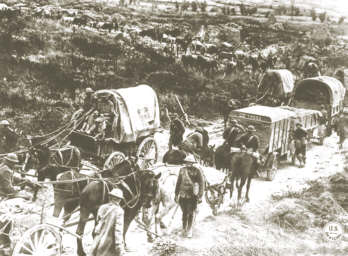The Story of the American Expeditionary Forces |
 Advance Section |
ADVANCE SECTION
|

Supply Trains

|
The supply columns pictured above performed the final steps in the process of getting the frontline doughboy the weapons, equipment, food and supplies he needed to fight. The Army official history describes the way the system worked in this fashion: The Advance Section delivered supplies received from the Intermediate and Base Sections forward to a point where delivery was made to field transportation of combat forces; here the Regulating Officer, a direct representative of GHQ, assumed responsibility, the Advance Sectionís authority ceasing.
The accomplishements of the Advance Section and its parent organization the Services of Supply are, even today, stunning. And it was all done from a dead stop in fits and starts. The hospitals they built were caring for 190,000 doughboys on their peak day. The forestry troops milled 200,000,000 feet of lumber and 4,000,000 railroad ties. One of their mechanized bakeries produced 800,000 pounds of bread each day.  A Wounded Doughboy Receives First Class CareThese records would have been far surpassed had General Pershing received all of the 4.7 million troops planned for the Expeditionary Force, and the Advance Section required to meet their proportionally greater demand. But the war ended earlier than anyone planned. Maybe more than the contributions of the combat arm the future enemies and allies of the United States should have studied the performance of the Services of Supply in the Great War. All the potential for applying its industrial power to warfare was evident in 1918. |
|
Sources and thanks: Compiled by the Editor from American Armies and Battlefields in Europe and the US Army Official History of the World War.. Regular contributor Ray Mentzer provided the Photos. MH |
To find other Doughboy Features visit our |
Membership Information  Click on Icon |
For further information on the events of 1914-1918
visit the homepage of |
Michael E. Hanlon (medwardh@hotmail.com) regarding content,
or toMike Iavarone (mikei01@execpc.com) regarding form and function.
Original artwork & copy; © 1998-2000, The Great War Society

